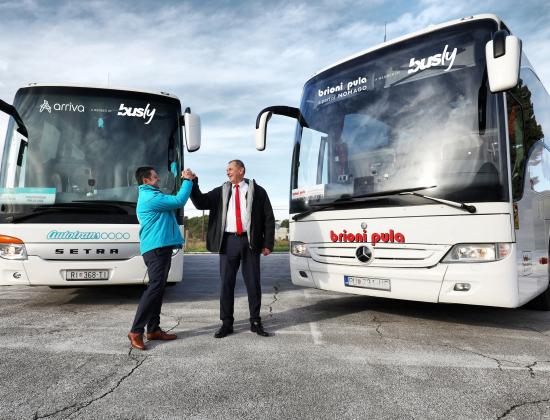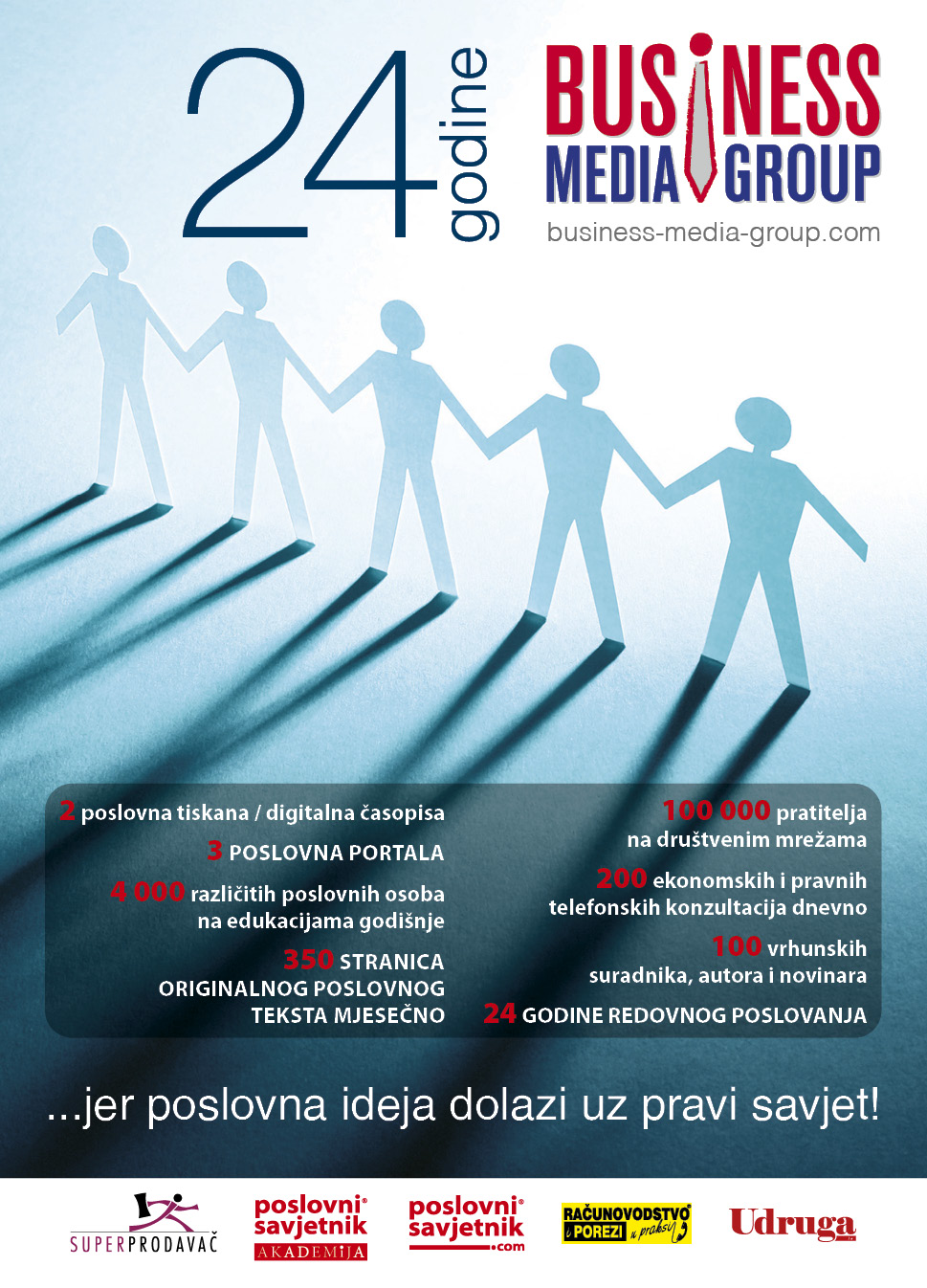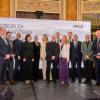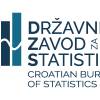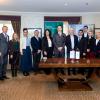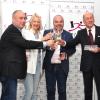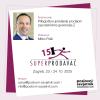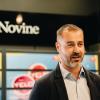John Lodder: Change is no longer a project

Because it’s Christmas Time I like to share some ‘Food for Thoughts’ for Leaders. During 2 years of the pandemic we saw disruptions in all markets and companies, the changing of ‘Change’ itself, the changing requirements of leadership, the leaving of employees and much more. This column is about what leadership could do to adjust their company to make it future proof. And about what leadership could do to increase engagement of your people and to make leadership more people oriented, connected and purposeful. I give you a summary of three relevant studies I will end with some information about ‘reinvention’ and an invitation to register yourself and / or your employees for a free ‘Reinvention course’.
When the future arrives
It used to be easy to turn off the future until after you retired or died. We could live with the world we had; long enough to avoid dealing with significant cultural or technical change. Sure, teenagers might listen to loud music or have long hair, but that didn’t mean you had to.
And there were parts of the world where the future would arrive five years after it had reached California or Kenya. There was always plenty of time to prepare.
But now, thanks to the networks and to the wired culture, that insulation is gone.
The future is here today! It’s not going away. And a new future is going to be here tomorrow! (Seth Godin)
The power of change
David Michels (Bain&Company) recently wrote that: “Change is continuous and accelerating and, being able to lead through change is no longer an optional skill.”
The last two years Michels and co. studied companies that are exceptionally good at managing change and what sets them apart. They learned that an organization’s “Change Power” exists out of nine different elements:
-Three leadership elements (purpose, connection and direction)
-Three organizational elements (development, flexibility, and action)
-Three teaming elements (choreography, scaling, and capacity)
Their research across multiple industries and geographies suggests that each company seems to have its own distinct balance of these nine factors. When it comes to their overall power to change, however, they typically fit one of four archetypes.
-In search of focus (37% of companies).
This was by far the most common archetype.
With great energy and constant innovation, staff can take on a lot, but, similar to young children playing soccer, everyone is chasing the ball. These companies lack direction, purpose, and connection.
Their leaders need to focus on the big picture, connecting company activities to purpose and strategy, and prioritize, saying no to some good initiatives in order to stay focused on the best.
-Aligned but constrained (24% of companies).
This group works well as a unit in lockstep, yet often lacks the people needed to manage greater amounts of change and disruption. That leaves them feeling as if they’re running a race in the mud, struggling with capacity, development, and connection.
These organizations need to identify and address their capacity bottlenecks, reorder their priorities, and add resources where most needed.
-Stuck and skeptical (20% of companies).
Companies that fit this archetype have good ideas and a history of success, but too much of their change gets stuck at the local level. They are weak in scaling, action, and connection, and they are unable to spread innovation across the organization.
That leaves their people impatient, skeptical, and even at times a bit hopeless.
Moving forward will depend on reigniting the enthusiasm of teammates and convincing them that success is possible.
-Struggling to keep up (19% of companies).
This group is similar to a team of cyclists in the Tour de France, battling a grueling race with many stages. They’re great athletes with a single-minded focus and an action orientation, and they have delivered results. But as the race wears on, fatigue sets in, and their weakness in flexibility, choreography, and scaling becomes a liability. Companies in this category need to better anticipate what’s around the corner and change their plans accordingly, evaluating whether their strategic direction is still the right one.
Which one of these four looks (most) like your company or department?
Purpose for the long term
Of all the elements of change, purpose has been the hottest topic of conversation among executives this year. A survey Bain did of nearly 1,000 people around the world during the early months of the pandemic, they found that, among employees whose satisfaction with their company had increased during the crisis, 86% said their employer has a purpose that its people are passionate about and that they found meaningful. At its core, purpose is the reason a company exists, it’s what gives meaning to employees’ everyday work. It’s important that it supports the CEO’s vision and strategy, but it is a notion that is best considered over the long term, far beyond the retirement date of today’s leadership team.
The pandemic has given leaders the opportunity to reignite their corporate purpose by studying what the organization learned about itself during recent crises. What brought employees together, what made them proud of their organization and deepened their engagement?
A clear purpose is critical to making change that lasts. As change becomes more pervasive and companies’ employee bases more diverse, there’s a strong need for a unifying anchor that provides context and focus. Purpose creates an important sense of belonging and attachment. It’s not a slogan, but it’s the driver that defines and guides action.
During periods of crisis, purpose proves its worth, but it’s a competitive advantage whatever the business cycle.
Thriving in the new hybrid world
One of the greatest changes leaders have had to navigate this year is the revolution in how we work. From Zoom fatigue to the “new normal,” Covid-19 has accelerated a decade of behavior change into one year. While we miss one another and the deeper, more substantial interpersonal connection and interactions of in-person gatherings, virtual formats have their own advantages. The greatest is the ability to scale the number of participants, no matter their location, at incredibly low cost and minimal carbon footprint. The less obvious advantages include the ability to customize experiences for subgroups of participants, to gather and analyze data in real time, and to co-create together in large groups.
If you want your top 1,000 people across the globe to jointly refresh your company’s mission, values or purpose, the right virtual design can make that not only possible, but fairly easy.
Like the center of a Venn diagram, hybrid work seeks to bridge the virtual and physical environments and capture the best of each. The conversations and content that benefit most from nonverbal communication and eye contact can be executed in person, and the material suited to the scale, transparency, and visibility of virtual interaction can be covered via Miro, Trello, Zoom, etc.
As you think forward to 2022, whether setting up regular meetings, scheduling steering committee sessions, or planning bigger events or workshops, hitting the proper hybrid balance starts with asking the ‘four Ws’:
- Why: Why are we gathering? What is the purpose?
- Who: Who are the participants and what are we trying to achieve with them? Think of this as casting. External parties, facilitators, your own front liners, almost anyone can parachute in virtually from anywhere in the world.
- What: Which of the many virtual tools that are available or that we’ve tried over the past year could help us meet our goals? With What subjects can we benefit from in-person interaction, with What can we benefit from virtual?
- How: How can virtual and in-person intersect, and for which participants? What new possibilities are opening up?
10 Key Talent and Leadership Trends For 2022
Jeanne MacDonald (Korn Ferry) presents the results of a global Korn Ferry survey; it’s summarized in 10 Key Talent and Leadership Trends for 2022.
1. The Great Resignation gets worse
For some time, companies have struggled with a shrinking talent pool, but the global pandemic accelerated this talent shortage to a degree no one could have predicted. This recent Korn Ferry survey shows 55% of professionals believe employee turnover will increase in 2022 and 31% say they would leave their job even if they didn’t have another one lined up.
To crack a tight labor market, companies are increasing starting salaries, offering more long-term incentives and benefits, and paying sign-on bonuses, even for less-senior hires.
2. The rise of the career or digital nomad
Today’s workspace is being transformed before our eyes; people are working anywhere, everywhere and at any time. Professionals are on the move, Boomers are retiring, and career nomads are looking for change, early and often. In fact, in the survey, 32% of professionals say they don’t think they’ll ever go back to the office full time.
In another survey, 36% of professionals say they plan to take a different job in the near future because the pandemic allowed them to re-evaluate what they want and the change they need. Workers are embracing agility like never before.
3. Ongoing connection conundrums
The pandemic caused us to move from hour(s)-long in-person meetings to condensed half-hour Zoom calls, and virtual everything. In 2022 leaders need to be more deliberate about creating opportunities for deeper connections within their companies or else risk employees going deeper into silos.
Organizations must instill a culture of listening, understanding and inspiring employees to feel more connected.
4. Focusing inward
Facing a talent shortage means organizations will start to focus more on internal mobility, reskilling and upskilling existing employees to prevent attrition and fill niche roles.
To achieve their reskilling goals, some companies are upping their training, development, coaching and mentorship programs and creating more on-the-job learning experiences, while others are investing in new technologies to help advance careers.
5. Moving from disruption to reinvention
Much of the past two years has been about organizations changing what they did and how they did it because they had to, without much consideration or planning for the future.
But there is a flip side to this disruption: if companies can harness the agility and flexibility shown by their workforces, they have an opportunity to reinvent themselves for a new age: finding solutions for shortages, climate change, digital acceleration, supply chain issues and ever-shifting consumer demands.
(In my May 2021 column I wrote specific about the necessity of ‘Reinvention’. JL)
6. Enhanced action on sustainability
ESG and sustainability issues are now firmly on the boardroom agenda. The demand for organizations to take action will grow more intense in 2022.
More and more organizations are waking up to the reality that science alone will not get them where they need to be. Meaningful transformation requires changes in mindset and skillsets.
7. Doing well by being well
Employees feel increasingly burned out from an abundance of Zoom sessions, a lack of connectedness to colleagues, lack of separation between work and home, and myriad personal challenges rising from the pandemic and social unrest.
Organizational leaders are increasingly putting ‘employee wellbeing’ center stage. This is far more than introducing mental health initiatives or fitness-related perks.
Culture change is required. Leaders need to become skilled at discussing mental and personal health with team members, not an area of leadership development many have focused on before.
8. Casting a wider net in the search for talent
Faced with a chronic talent shortage, organizations are easing up on job qualifications like four-year college degrees and set years of previous experience, as well as resume gaps, as they cast a wider talent net.
What’s more, employers are going outside of their industry, within the retired workforce, and to other nontraditional places to find the people and skills they need.
9. Greater accountability
As remote and hybrid working become normalized, leaders recognize that in 2022 they will need to devote more time to building new working cultures to match. Welcome to a world of frequent check-ins and continuous feedback, where agile, collaborative employees are most likely to thrive.
Increased accountability is hitting the C-suite, too. Corporate leaders are under increasing pressure to hire and develop people from underrepresented groups, pay workers equitably and take stands on social issues.
10. The shift from “me” to “we”
The last 24 months have brought us once-in-a-generation levels of global disruption and political unrest. They have also given us the very best that humanity can offer, whether it’s the scientists who developed vaccines at record-breaking speed or communities that rallied together through difficult times.
What we all have learned is that it pays to work together for good. Community doesn’t just give us meaning, it gets results. In the year ahead, we expect to see a rise in collaborative working practices and shared goals.
What is a Great Boss? How does (s)he look like?
Based on her own research, Toni Pristo gives us clear examples how a great Boss could / should look like.
She refers to the same Gallup report that I used in my July 2021 column from which I added a few specific data.
Having a great boss should be a desirable feature of an organization’s leadership culture.
Yet despite earnest attempts in training and development, we have a long way to go. Gallup reports that one in two U.S. adults have left their job to get away from their manager and improve their overall life at some point in their career. But there is more.
So many of the formidable human capital challenges facing companies today are those in which the manager plays an integral role:
-As a result of the worldwide Covid-19 pandemic, record numbers of people are leaving their jobs in search of better ways to work and live. Contributing to the Great Resignation are unreasonable manager practices that lead to inordinate workloads and employee burn-out.
-Gallup Engagement Survey results for 2021 show that 65% of U.S. employees are actively disengaged. They report “miserable” work experiences and poor management.
-In Croatia 88% of employees are disengaged. For Eastern Europe it is 79%, Western Europe 89%, Global 78%. Of Global management 65% is disengaged.(JL)
-People’s cry for inclusion, equity and belonging continue to increase with a dramatic intensity.
Perhaps the simplest and best response to the common thread among these issues is to re-focus attention on the relationship between a boss and direct reports, not just in the belly of the organization, but at every level. So what is ‘Best Boss’ behavior?
A Best Boss focuses on the what, how and why of interacting with direct reports in ways that matter, both to the relationship itself and to the needs of the business. Research shows five key, intersecting areas.
1. Leading from a Higher Purpose
In balance with a focus on the business and self-interest, a Best Boss prioritizes and holds the best interests of direct reports at heart in a way that is authentically felt by the other.
An evolving trust and mutual respect becomes the overriding foundation for all conduct because the employee senses the value the boss places on the interpersonal relationship.
Some leaders are quite overt with this leadership philosophy. Other leaders may never explicitly articulate a higher purpose (or have reflected on this personally). Yet, their behaviors clearly convey the notion.
2. Activating Potential
A Best Boss observes values and puts to use the knowledge, skill and experience of an employee.
The boss also understands there is additional potential inherent in an employee and seeks to provide opportunities to cultivate it in the context of both employee interest and business need.
3. Promoting Dynamic Autonomy
A Best Boss conveys vital information on an ongoing basis to otherwise autonomous direct reports so they can perform optimally. These bosses impart the “big picture” surrounding the organization from both a strategic and external perspective (e.g. competitive landscape). They also provide clear expectations and describe line of sight so employees understand the connection between their goals and those of the organization.
4. Providing Pervasive Feedback
The Best Boss doesn’t miss an opportunity to provide constructive and reinforcing feedback to a direct report. With trust as the backdrop, feedback flows freely. A great boss realizes there is no successful system that operates without ongoing, multifaceted feedback.
5. Inspiring Continuous Learning
The Best Boss sets up a culture of continuous learning by sharing an open philosophy regarding mistakes.
Employees are encouraged to discuss mistakes when they occur. Together, they mine lessons learned from the situation. Finally, all relevant learning is applied going forward.
This practice fuels employee confidence and instills learning agility.
The Best Boss approach to mistakes increases the employee’s propensity for taking calculated risks over time. This comes as a result of being freed from the fear of failure, as well as having increased opportunities to learn from experience, buoyed by the boss’ ongoing feedback.
For me these 3 studies provide a clear ‘red thread’ about the opportunities for tomorrow and what leaders and their organizations could / should change and improve. How to get there where you want to go with your people, and to co-create sustainable results for your organization, the sustainable approach is ‘reinvention’.
Reinvent your business before it is too late
Executives in business who are seeking to improve their chances of survival do well to study a timely new book by “Chief Reinvention Officer” Nadya Zhexembayeva: “How To Thrive In Chaos”. The most powerful message is that “Change is no longer a project!”
The challenge we face isn’t about trying to survive until things stabilize, but rather about learning to thrive in constant chaos. The trouble is that in many big businesses, even after years of hierarchies being flattened, too many people are still too far away from the customer to properly understand their market or even to know whether they still have one.˝ (Roger Trapp, Forbes)
To survive over the long haul, a company must reinvent itself periodically, jumping from the flattening end of one business performance curve to the rising slope of another. (see figure 1)
Very few companies make the leap successfully when the time comes. That's because they start the reinvention process too late. Once existing business begins to stall and revenue growth drops significantly, a company has less than a 10% chance of ever fully recovering.
There is a striking difference between companies that have successfully reinvented themselves and those that failed. High performers manage their businesses not just along the growth curve of their revenues but also along three much shorter, though equally important, S curves: tracking the basis of competition in their industry, renewing their capabilities, and nurturing a ready supply of talent. By planting the seeds for new businesses before revenues from existing ones begin to stall; these companies enjoy sustained high performance.
What is new is the increasing higher speed that threatens the lifecycle of organizations, see figure 1.
(The lifecycle is clearly explained in this course)
The average lifetime of a company shortened from 75 year in the 1960’s to 6 years in 2020.
To survive organizations are forced to anticipate faster as ever to developments in their different markets (e.g. employees, core business, customers, competitors, suppliers, sustainability, laws etc.) and take action.
We call this action to survive: ‘re-invention’. (We base the average maturity / top of an organization at 50% of the Gauss-curve.)
In average, companies reinvented itself at 37,5 years in the 1960’s which went up to an average reinvention every 3 years in the 2020’s. (Based on annual surveys of the Reinvention Academy)
My message for CEO’s, managers and leaders is:
The only way to future-proof your business is for the leader to embrace ‘the art of changing’: ˝Change is not a punishment; Change is the ultimate freedom to make a choice!˝
Integrate ‘change readiness’ in your organization culture and apply:
-Even if it is not broken Fix it, you don’t have much time
-Break and fix it before somebody else in your market does it.
Now ask yourself: How good is my organization in changing and reinventing?
- Excellent, we rock!
- Good, but could be better.
- We only see change when it hits us.
I suggest you invest 7.5 hours in yourself, in your leaders, in your talents and/or HR professional(s), certainly if you scored your company at 2 or 3.
Nadya Zhexembayeva (Chief Reinvention Officer) invites you and your people for this free webinar:
"How to Plan in Uncertainty: learn 5 Top Tools to Take Control of the Unpredictable 2022!"
The end of the year is usually when we get to plan for what's ahead - but how do you plan in uncertainty? How do we all take control of the unpredictable 2022 - especially now, when omicron is once again testing every limit, when "the great resignation" meets "the great burnout," when supply chains are falling apart?
One trick is to move away from setting the goals in singular, absolute numbers and moving to the ranges.
For example, instead of setting a goal of "market share of 22%" go to "market share from 18 to 25%."
Harvard Business Review reported that going to a range when setting a goal significantly impacts sustained motivation (the problem we all face these days). For example, in one study, participants who worked with a single goal stuck with the effort 50% of the time, but those who worked with a range persisted 80% of the time.
This is just one of many science-based solutions for meaningful high-impact planning in times of extreme uncertainty, but there is so much more.
That's why from January 10th to 14th, we'll be holding our free live online Easy Reinvention Lab – to give you all the tools needed to take control of unpredictable 2022.
All you need is 1.5 hours a day as we give you:
- a diagnostic to measure your own or your organization's change readiness (aka "Titanic Syndrome Test")
- a neuro-science based exercise on addressing resistance to change in 15 minutes
- a reinvented Blue Ocean Strategy canvas to get into the minds (and wallets) of your customers and prepare for their new demands...and so much more.
Registration is free - and 272 professionals have already secured their spots.
With only 1.5 hours a day, you will leave the Lab after 5 days with clear ideas, powerful tools, and an implementable plan (even in the face of complete uncertainty). Register today>>>
Or at: https://www.learn2reinvent.com/lab
Dr. Nadya Zhexembayeva, Founder & Chief Reinvention Officer
Reinvention Academy
I wish you peaceful Christmas times and a healthy start into a beautiful, enjoyable and successful 2022. I’m looking forward to finding out what changes and reinventions 2022 will bring us and which ones we will start.
For this column I was inspired by Jeanne MacDonald MSc.; Seth Godin (so far the only person in 3 Marketing Halls of Fame); David Michels; Toni M. Pristo, Ph.D.; Dr. Nadya Zhexembayeva.
John Lodder
(ps/sm)


